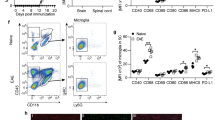Summary
Cultivation of measles virus (SSPE virus, Lec strain) persistently infected C 6 rat glioma cells at 39°C resulted in the loss of detectable expression of measles virus proteins. Temperature shift-back led to reactivation of measles virus even after maintenance of the cells at 39°C for 15 days. In Northern blot analysis viral mRNA disappeared at 3 days after shift-up whereas 50 S viral genome-sized RNA was detectable until 6 days. The 50 S RNA decreased in quantity in rough correlation with dilution by cell passage at 39°C. The 50 S viral RNA was found in the nucleocapsid fraction. On day 9 after shift-down of persistently infected cells, maintained at 39°C for 15 days, 50 S viral RNA reappeared although mRNAs were not yet detected. Infectious center assays showed that the number of cells in the population at 39°C, which contained an SSPE virus genome that could be reactivated, declined after temperature shift. Moreover, cell cloning experiments, in which single cells of cultures maintained for various lengths of time at 39°C were incubated at 35°C and examined by immunofluorescence, reconfirmed the above results. This indicates that the reactivation of SSPE virus described here was due to re-infection of virus-antigen negative cells with progeny virus produced by a few latently infected cells in the population. The biological significance of this phenomenon in the central nervous system virus infection is discussed.
Similar content being viewed by others
References
Andzhaparidze OG, Chaplygina NM, Bogomolova NN, Lotte VD, Koptyaeva IB, Boriskin YUS (1987) Non-infectious morphologically altered nucleocapsids of measles virus from persistently infected cells. Arch Virol 95: 17–28
Baczko K, Billeter M, ter Meulen V (1983) Purification and molecular weight determination of measles virus genomic RNA. J Gen Virol 64: 1409–1413
Barrett PN, Koschel K (1983) Effect of antibody-induced modulation of measles (SSPE) virus membrane proteins on β-adrenergic receptor-mediated adenylate cyclase activity. Virology 127: 299–308
Barrett PN, Koschel K, Carter M, ter Meulen V (1985) Effect of measles virus antibodies on a measles SSPE virus persistently infected C 6 rat glioma cell line. J Gen Virol 66: 1411–1421
Cane C, McLain L, Dimmock NJ (1987) Intracellular stability of the interfering activity of a defective interferin influenza virus in the absence of virus multiplication. Virology 159: 259–264
Chui LW-L, Vainionpää, Marusyk R, Salmi A, Norrby E (1987) Nuclear accumulation of measles virus nucleoprotein associated with a temperature-sensitive mutant. J Gen Virol 67: 2153–2161
DePolo NJ, Holland JJ (1986) The intracellular half life of non-replicating nucleocapsids of DI particles of wild type and mutant strains of vesicular stomatitis virus. Virology 151: 371–378
Haase AT, Ventura P, Gibbs CJ, Tourtellotte WW (1981) Measles virus nucleotide sequences: detection by hybridizationin situ. Science 212: 672–675
Halbach M, Koschel K (1979) Impairment of hormone dependent signal transfer by chronic SSPE virus infection. J Gen Virol 42: 615–619
Koschel K, Münzel P (1980) Persistent paramyxovirus infection and behaviour of β-adrenergic receptors in C 6 rat glioma cells. J Gen Virol 47: 513–517
Miller CA, Carrigan DC (1982) Reversible repression and activation of measles virus infection in neural cells. Proc Natl Acad Sci USA 79: 1629–1633
Münzel P, Koschel K (1982) Alteration in phospholipid methylation and impairment of signal transmission in persistently paramyxovirus-infected C 6 rat glioma cells. Proc Natl Acad Sci USA 79: 3629–3696
Ogura H, Baczko K, Rima BK, ter Meulen V (1987) Selective inhibition of translation of the mRNA coding for measles virus membrane protein at elevated temperatures. J Virol 61: 472–479
Ogura H, Rima BK, Tas P, Baczko K, ter Meulen V (1988) Restricted synthesis of the fusion protein of measles virus at elevated temperatures. J Gen Virol 69: 925–929
ter Meulen V, Carter MJ (1982) Morbillivirus persistent infections in animals and man. In: Mahy BWJ, Minson AC, Darby GK (eds) Virus persistence. Cambridge University Press, Cambridge, pp 97–132
Udem SA, Cook KA (1984) Isolation and characterization of measles virus intracellular nucleocapsid RNA. J Virol 49: 57–65
Yoshikawa Y, Yamanouchi K (1984) Effect of papaverine treatment on replication of measles virus in human neural and non-neural cells. J Virol 50: 489–496
Author information
Authors and Affiliations
Additional information
On sabbatical leave from the Queen's University of Belfast, Belfast, Northern Ireland.
Rights and permissions
About this article
Cite this article
Ogura, H., Rima, B.K., Baczko, K. et al. Long-term effect of elevated temperatures on SSPE virus expression in persistently infected rat glial cells. Archives of Virology 104, 259–269 (1989). https://doi.org/10.1007/BF01315548
Received:
Accepted:
Issue Date:
DOI: https://doi.org/10.1007/BF01315548




